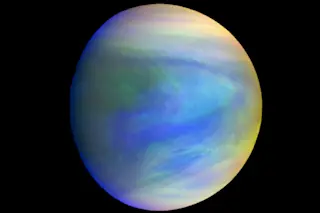Something mysterious swirls amidst the clouds of Venus.
The planet’s hot, harsh atmosphere is thick with carbon dioxide and sulfuric acid. Atmospheric gases circulate amid cloud layers according to patterns that scientists don’t fully understand. And Venusian clouds also contain strange, dark patches, called “unknown absorbers” because they absorb large amounts of solar radiation.
No one has yet determined what these dark patches are, but scientists have speculated that they might be forms of sulfur, ferric chloride or even microscopic life.
Now, a team of scientists led by Yeon Joo Lee, a researcher in the Center for Astronomy and Astrophysics at the Technical University of Berlin, has shown that the unknown absorbers are affecting Venus’s weather.
On Venus, as on Earth, the energy that drives the atmosphere’s winds comes from the Sun. By studying more than a decade of data from Venus Express, Akatsuki, Messenger and the Hubble Space Telescope, ...














